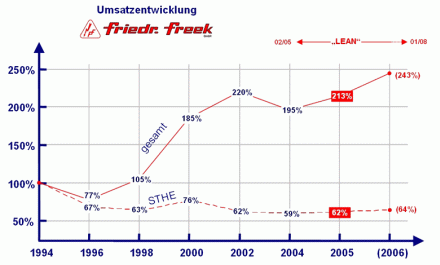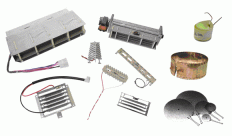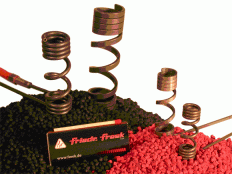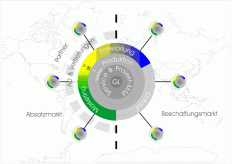Success with simple standard products - 16.03.2007
Appropriate structures allow production of simple products in Germany (from Jörg Abel, Dortmund, and Stefan Kaiser, Menden)
The current discussion about safeguarding jobs in Germany focuses high-tech-products; simple standard products (e. g. products in the sectors metal manufacturing and processing, paper and printing industry) are, according to the common perception, not producible at reasonable costs and will be shifted into low cost countries sooner or later. However, the example of Friedr. Freek GmbH shows that producing simple products can have a future even in Germany if the according organisational and personnel structures exist.
Friedr. Freek is partner company in the combine project "Lean Implementation – Pragmatische Einführung ganzheitlicher Geschäftsmodelle in Unternehmen der einfachen Standardfertigung" (Lean Implementation - of integrated business models in companies with simple standard production") which is supported by the BMBF through its project executing organisation Forschungszentrum Karlsruhe (www.lean-implementation.de), which is coordinated by the chair for economic and industrial sociology of the University of Dortmund.
Initial situation
The general decline of industrial production in Germany, the price pressure, the increasing imports of simple products as well as the shifting of unqualified, mostly manual production tasks in low cost regions such as Eastern Europe and Asia suggests that the production of simple standard parts in our home country will be on the brink of collapse shortly. Simple standard products are products which are characterised by a low technical and functional complexity and a high level of standardisation, often produced in big series and based on a technically mature principle (for example vendor parts in metal or plastic, furniture etc.) [1]. Social scientifical studies show that the producing companies, mostly small and medium-sized enterprises (SME), hold potentials with which they can safeguard and improve their competetiveness in spite of alleged disadvantages concerning the (labour) costs [1]; [2].
SME with "simple standard production" are characterised by some specifics, which can be interpreted both as strength and as weakness. Among the strengths is the high flexibility due to the small company size, which is reflected in a low level of formalisation of the organisational structures. As weaknesses have to be named the limited acting potentials and strategic capabilities, which result from the small personnel and financial capacities. Because of a usually proprietor concentrated management, SME have rather a trust-based business culture [3]. Based on their specific organisational and personnel structures the SME can act successfully despite of their dual problem - limited capacity and simple standard products.

standard heating elements (STHE) and products in total.
The studied company and the products
Friedr. Freek is a company with appr. 50 employees managed by its proprietors, which is based in Menden, near Dortmund. It produces so-called standard heating elements (STHE), picture 1, and technically advanced HotMicroCoils (HMC), picture 2, a third main pillar are trading goods. Especially the STHE are a mature business sector, with only few possibilities for innovations. The customers are from the household appliances industry, the plastics machine construction, the medicine and laboratory engineering as well as canteen kitchen suppliers. Turnover in 2006 was appr. 6 million Euros, picture 3.
In the production perform appr. 35 employees, often with migration background and without a completed apprenticeship, the mainly manual operations at simple machines. In the administration (marketing and development, internal services etc.) work appr. 15 employees with commercial or engineering education. The structural organisation is deliberately held simple, the hierarchy is very flat.
The economic situation is characterised by worldwide competition and the associated price pressure, especially for the standard product STHE. This led to a slowdown in sales in this product group. Meanwhile turnover recovered which can be attributed mainly to innovations and a permanently high quality standard.
Thus two product-related factors are named, which allow also German companies with a simple standard production to survive in spite of the heavy price competition on the world market. Freek deliberately keeps out of price competition and focuses on a niche strategy instead and with it on the strategy of technology leadership (custom-made solutions, high quality). Moreover, with organisation and personnel policy, further central factors can be identified, whose influence on the success must not be underestimated.
Organisation structure
Among the results of a current McKinsey-study [4], which deals with success factors of medium-sized enterprises, is the aspect "consistent professionalizing of the management". Even though Freek can meet the requirements given by McKinsey only in parts (separate organisation units for central functions, management with comprehensive leading and industry experience, variable salary), this factor nevertheless shows the high significance for economical success.
Freek's organisation chart reveals that there are no similarities with well-known types of structural organisations. There is neither a classic line organisation, a function system nor a business unit organisation. In fact, particular operative tasks are specified, where already the chosen display format shows that they are not strictly divided, Picture 4.
Goal of the structural principle is to minimize the fundamentally problematic interfaces in the administration between departments, to encourage communication and to avoid narrow-mindedness. The advantages become evident in the realisation: single employees are not assigned to a department but there is a bundling of tasks which are handled by teams, especially proved by the task bundle marketing, sales and development.
Flat hierarchies go along with this. The management is on top, in the administration there are no other executives below; in the production has been added the hierarchy level of a production manager and his deputy. Connected with the flat hierarchy, especially in the administration, is a high autonomy of the employees for their scope of functions and only little formal planning effort.
This organisational structure offers a number of advantages, especially for the administration. The high autonomy, resp. the big scope for decisions relieves the management immensely from the operative day-to-day business. Thus it escapes a fate which can be observed in many owner-operated SMEs. Occupied with daily decision processes it lacks time to pay attention to the more and more important strategic planning.
Furthermore, the employees' motivation is boosted. The possibility to make independent decisions is an important precondition, especially for (highly) qualified employees to enjoy the work. A further, already mentioned advantage is reducing the interfaces and thus an increase of flexibility. This can be seen at the quick response to inquiries, which at Freek are handled according to the motto "We supply when the others have written the quotation".
Staff Assignment
With the concept for staff assignment Freek intends to achieve two goals. On the one hand it concerns the amount of the labour costs. In order to organise them competitively, Freek start in the production. Recruiting low-qualified employees and home workers for the simple production and assembling jobs contributes to cost reduction. In addition it is tried to use instruments of the labour market policy to reduce costs (such as subsidies from employment centres).
The second goal is the maintenance of the necessary flexibility. This is achieved by an accordant design of the employment contracts in which it is tried to combine the interests of both, the employer and the employee. This becomes obvious at the part time contracts where the agreed working time can be increased or decreased at short notice. Moreover, flexibility is secured by working time flexibility. In the production there is a span of 35 to 42 working hours per week, to which can be resorted depending on the order situation. The flexibility also includes the Saturday as a working day. Is overtime pending, the employees are informed in good time; is there overtime for a longer period, the employees have the possibility to decide under which conditions they would like to carry it out.
The model which is behind the organisational structure and the concept of staff assignment, is called "Keep It Simple Stupid (KISS)". The dictum of this model is that jobs and projects should be processed as simply as possible and problems should be solved as simply as possible. The functionality of the model is guaranteed by the flat hierarchy, the short communication ways as a result of missing department structures as well as avoiding bureaucracy.
Corporate philosohpy
The "cement" which bonds the single bricks is a corporate philosophy which does not, as in many other companies, hang out everywhere in production and administration, nevertheless it is lived. These corporate guidelines comprise aspects such as concentration on the own strengths without being ashamed of one's shortcomings, not to view problems and conflicts as negative but justified within the nature of the task or to realise the claim to have an image as a problem solver for the customers.
Remarkable is not the content of this philosophy but the employees' reference to it in their day-to-day business. The contents are - whether consciously or unconsciously - the guideline for the internal cooperation. It is secondary if the guideline can be recited by the employees, important is that the "spirit" is understood and to have a management which acts according to its guidelines.
A cooperative management style is beneficial. This manifests especially in the employees' decision and involvement scope. They are intensely included into bigger investment projects, e. g. in the acquirement of a new ERP (Enterprise Resource Planning)-system. Furthermore, they can make their own extensive decisions in their daily work without having to ask for the management's permission. The management stands behind the employees even if they made a wrong decision. This arrangement leads to a close cooperation within the company. Or as an employee said: "We beam positively!"
Conclusion
The example of Friedr. Freek GmbH shows that it is possible for SMEs to successfully produce simple standard products under German conditions as well. In order to safeguard this success it is necessary to have competetive products (niche production, high quality, problem solver qualities), optimised processes and integration in networks [5], though also a flexible working organisation and structural organisation as well as a matching personnel policy. Can the companies also accomplish to merge all these separate parts by a common benchmark such as a motivating corporate philosophy the chances for producing simple products in Germany are good.
Literature
- [1]
- Schmierl, K. (Hg.): Intelligente Produktion einfacher Produkte am Standort Deutschland. Frankfurt/New York, 2000.
- [2]
- Bender, G.; Jacobson, D.; Robertson, P. (eds.): Non-Research-Intensive Industries in the Knowledge Economy. In: Perspectives on Economic Political and Social Integration, Special Edition, XI, No 1-2, 2005.
- [3]
- Hirsch-Kreinsen, H.: Internationale Netzwerke kleinerer und mittlerer Unternehmen. In: H. Hirsch-Kreinsen; M. Wannöffel (Hg.), Netzwerke kleiner Unternehmen, Berlin, 2003, S. 9-34
- [4]
- Unternehmertum Deutschland: Perspektiven für profitables Wachstum. Ergebnisse der Mittelstandsinitiative "Unternehmertum Deutschland". Düsseldorf, 2005.
- [5]
- Kaiser, S.; Kaiser, W. (Hg.): Chance Kooperation – ein Leitfaden für kleine und mittlere Unternehmen. Stuttgart, 2000.
older article newer article



